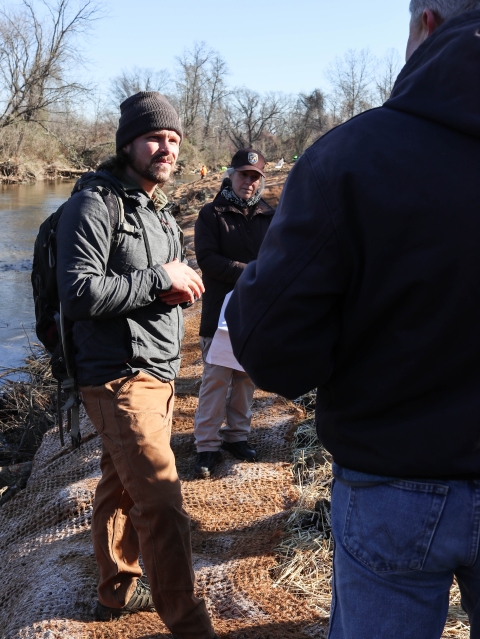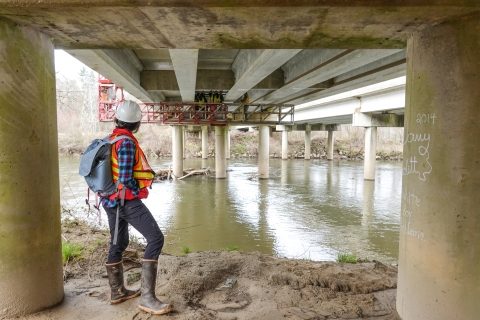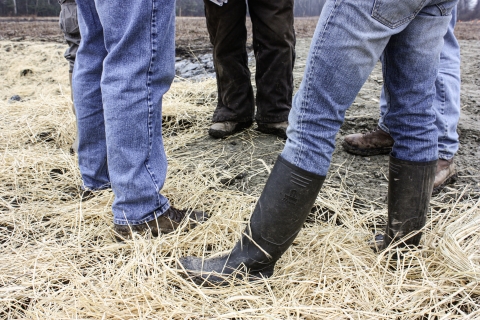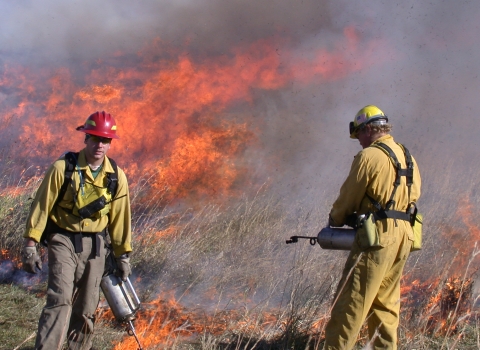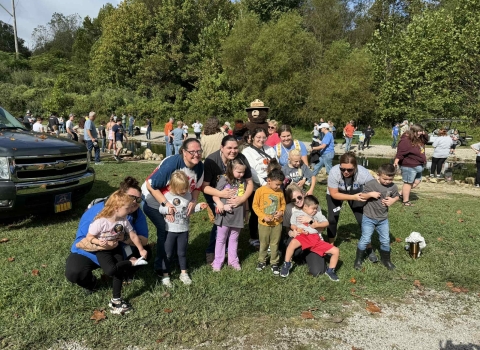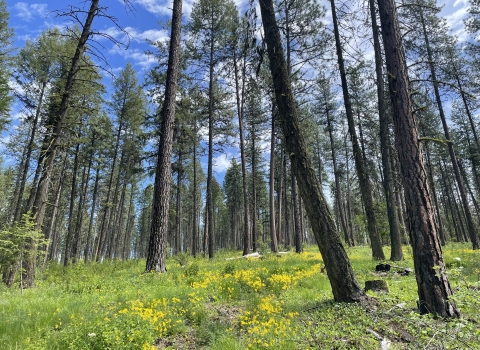Endangered Species and Development
What really happens when a construction project meets an endangered species?
It’s often perceived that the presence of a threatened or endangered plant or animal means the end of a construction project but what it really signals is the start of a conversation about the project and how any adverse impacts can be minimized and hopefully eliminated. The focus isn’t on whether a project moves forward, but how it moves forward.
In short
- Any federal agency funding, permitting, or implementing a project is responsible for evaluating project impacts to federally threatened or endangered species. If there are adverse impacts, they consult with U.S. Fish and Wildlife Service (Service) biologists.
- This consultation process is a conversation between Service staff and staff of the federal agency involved, or their designee, as opposed to a public input process.
- While federal agencies typically work to decrease or eliminate adverse impacts to protected species, such impacts may be allowed if they meet certain conditions.
- Proponents of construction projects with no federal involvement can design their project to avoid adverse impacts to listed animals or receive a permit allowing incidental adverse impacts after they commit to a habitat conservation plan benefiting the animal in question.
- Bald eagles are not protected under the Endangered Species Act, though they are still protected by other federal wildlife laws and there is a permitting process for activities that may impact them.
What does the Endangered Species Act say?
The Endangered Species Act is the nation’s preeminent law for conserving our most imperiled plants and animals. It has two key sections that come into play in these situations:
- Section 7 Section 7
Section 7 Consultation The Endangered Species Act (ESA) directs all Federal agencies to work to conserve endangered and threatened species and to use their authorities to further the purposes of the Act. Section 7 of the Act, called "Interagency Cooperation," is the mechanism by which Federal agencies ensure the actions they take, including those they fund or authorize, do not jeopardize the existence of any listed species.
Learn more about Section 7 of the Endangered Species Act requires a federal agency funding (including grants), authorizing (including permitting), or implementing a project to evaluate the project for impacts to listed plants and animals and they’re prohibited from jeopardizing the existence of a species or adversely modifying habitat formally designated as critical to the recovery of a species. If there are adverse impacts, the federal agency typically works with the Service to minimize or eliminate them. If adverse impacts can’t be eliminated, they can be allowed under the Endangered Species Act, if they are incidental to otherwise lawful activities and don’t jeopardize the existence of the species or adversely modify habitat formally designated as critical for species recovery. This part of the act is about looking forward and anticipating and addressing potential impacts. - Among other things, section 9 of the Endangered Species Act prohibits an individual from harassing, harming, pursuing, shooting, hunting, wounding, killing, trapping, capturing, or collecting an endangered animal, or attempting to do so, without a permit. This typically applies to threatened animals as well, though it does not apply to plants. Violations of this section of the act are investigated by the Service’s law enforcement division and may result in civil or criminal penalties. This section of the act isn’t about planning or project review, rather enforcement kicks in AFTER an alleged violation.
How does this play out on the ground?
- When a federal agency authorizes, funds, or implements a project, under section 7 of the Endangered Species Act, they have a responsibility to evaluate the project for impacts to threatened or endangered species. If they find a listed species may be affected, they consult with Service biologists. Examples of this type of federal involvement include grants, permits (such as a Clean Water Act permit for impacts to streams or wetlands), or direct implementation of a project.
- Often, the federal agency takes proactive steps to minimize or eliminate adverse impacts, such as increasing sediment and erosion control measures or altering project timing to when the species isn’t present. They can also work with Service biologists to develop such measures.
- Adverse impacts that can’t be eliminated may still be allowed as long as two things hold true – 1) any adverse impacts occur incidentally to otherwise legal activities, and 2) the continued existence of a species isn’t jeopardized and habitat designated as critical for the recovery of a species isn’t adversely modified.
- This review process is typically routine and plays out thousands of times each year through established relationships between Service biologists and federal agency staff.
But what if federal agencies aren’t involved?
- Sometimes projects have no federal involvement, and in those cases the review process under section 7 of the Endangered Species Act doesn’t apply.
- Even if section 7 of the Endangered Species Act doesn’t apply, section 9 does. Section 9 prohibits an individual from harassing, harming, pursuing, shooting, hunting, wounding, killing, trapping, capturing, or collecting an endangered animal, or attempting to do so, without a permit. Often, this same prohibition exists for threatened animals as well - endangered animals are in imminent danger of extinction, while threatened animals are in danger of extinction in the foreseeable future.
- A private landowner has the option of developing and implementing a habitat conservation plan that spells out a commitment to do good things for the impacted species. With a Service-approved plan, the landowner would qualify to receive an incidental take permit, allowing adverse impacts to a listed species that are incidental to otherwise lawful activities. Alternatively, projects can be modified, with or without assistance from Service biologists, to eliminate adverse impacts.
- In situations where a private landowner is developing private land, with no federal connection, plants receive no Endangered Species Act protection against destruction or habitat modification. When it comes to plants, the Endangered Species Act still protects against 1) interstate or foreign commerce, including importing and exporting; 2) removal from federal land and subsequent possession; 3) malicious damage or destruction on federal land; and 4) removal, cutting, digging up, damaging, or destruction in knowing violation of state law or while violating state trespass law.
What about bald eagles?
- Bald eagles were removed from the list of threatened and endangered species in 2007, therefore no longer receive protection under the Endangered Species Act. They are still protected under the Bald and Golden Eagle Protection Act and the Migratory Bird Treaty Act. There is a permitting process for situations when impacts to bald eagle are possible. For more information on that process, visit https://www.fws.gov/story/do-i-need-eagle-take-permit.
Resources
- Endangered Species Act - https://www.fws.gov/law/endangered-species-act
- Regulations implementing the Endangered Species Act - https://www.ecfr.gov/current/title-50/chapter-I/subchapter-B/part-17
- Eagle management - https://www.fws.gov/program/eagle-management

